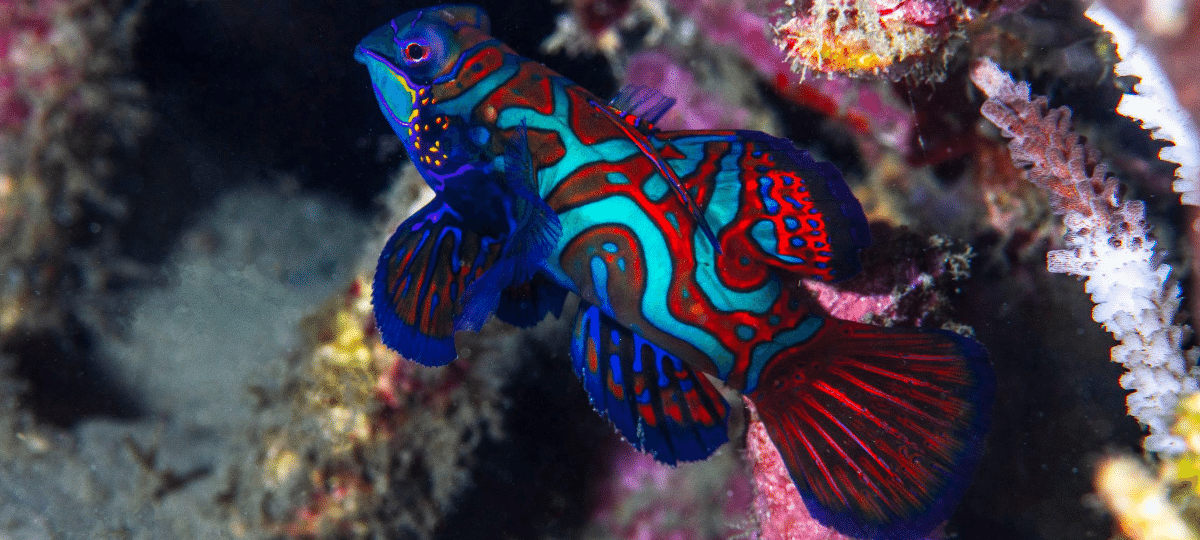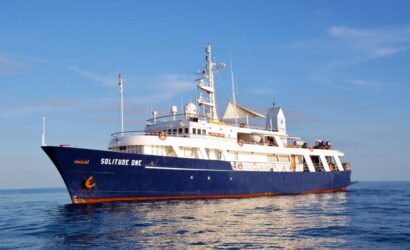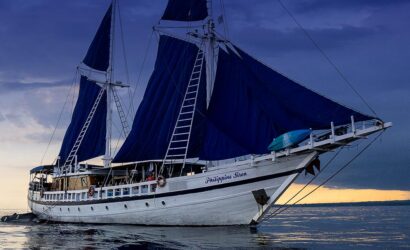Philippines

THE EPICENTER OF MARINE LIFE AND PELAGICS
Nearly 9 percent of the global coral reefs can be found in the Philippines and huge marine biodiversity. Scuba divers will find everything on their liveaboard trip from exciting wrecks, adventurous drift dives, whale sharks, thresher sharks and flourishing macro life.
The Philippines is an archipelagic country in Southeast Asia. Situated in the western Pacific Ocean, it consists of about 7,641 islands that are broadly categorized under three main geographical divisions from north to south: Luzon, Visayas, and Mindanao. And it has some of the best diving spots in the world as it is part of the coral triangle. No matter what diving experience or interest you have, you will find the right spot for you.
Wreck lovers will like the area around Coron, where some exciting wrecks can be found. Fans of sharks will not miss out to visit Malapascua for the thresher sharks. Speaking about sharks, the whale sharks migrating through the Philippines from January to May. The world-famous Tubbataha Marine Park attracts many many divers per year. And there are even some great spots for macro lovers around Mindoro Island and Puerto Galera.
WHEN IS THE BEST TIME TO VISIT THE PHILIPPINES?
The best time to dive in the Philippines is between November and May. From June to October is the rainy season and typhoons. The average yearly temperature is around 26 degrees and the water temperature ranges between 26 to 28 degrees. Sometimes it can drop down to 24 degrees.
WHERE TO DIVE IN THE PHILIPPINES?
Apo Reef & Coron: These are the hotspots for wreck lovers and fans of coral reefs. And here you can combine both. Coron is known as one of the best places in Asia for wreck diving. Apo Reef is considered the world´s second-largest contiguous reef system and the biggest in the Philippines.
Leyte: The diving hotspots are in the south of the Island. Divers can explore canyons, steep walls, healthy reefs and drift in strong currents. The region Panaon Island is known for the big stuff including manta rays, whale sharks (between November and May) and dolphins.
Mindoro: Here you can find a little bit of everything. 75% of the world´s coral species can be spotted here. Or fly in strong currents and passing by barracudas, tuna, batfish and more. Explore wrecks or discover small stuff like pygmy seahorses. Also, sharks can be seen here.
Tubbataha: This is a marine protected area with 97.000 hectares off the coast of Palawan. Two large atolls rising up from the bottom and create a rich reef with healthy marine biodiversity. This area is for big and small stuff as the water is so rich and nutrient. As this area is a bit remote, it´s best to explore by liveaboard. The best season is from March to June.
Visayas: The most known islands for diving in the Visayas are Cebu and Bohol. Probably the most popular dive spot of Cebu is Malapascua, where the thresher sharks can be spotted. Bohol is for reef lovers and fans of critters and colorful marine life.
LIVEABOARDS IN THE PHILIPPINES
As the Philippines are an island state, the best way to explore all the great dive spots is by liveaboard. Some regions have specific seasons, like the Tubbataha reef. The operators either offer trips around one region or even some transition trips, where you can travel from one famous dive region to the other.
Apo Reef / Coron
A PARADISE FOR FANS OF PELAGICS AND WRECKS
Combine world-class wreck dives with thrilling dives in a protected coral reef in one fantastic liveaboard cruise.
Apo Reef is a coral reef system in the Philippines situated on the western waters of Occidental Mindoro province in the Mindoro Strait. Encompassing 34 square kilometers (13 sq mi), it is considered the world’s second-largest contiguous coral reef system and is the largest in the country. The reef is a protected area and one of the best dive sites in the Philippines.
Coron is the third-largest island in the Calamian Islands in northern Palawan and well known as one of the best wreck diving destinations in Asia. All of these historical wrecks have their own reef system with loads of critters, including scorpionfish, nudibranch, eels, crustaceans, octopus. Find schools of fish like barracudas, sweetlips and fusiliers hanging around the wrecks.
WHEN IS THE BEST TIME TO DIVE IN APO REEF & CORON?
The best time to visit Apo Reef & Coron is between July and February.
WHAT ARE THE BEST DIVE SITES OF APO REEF & CORON?
Morazan Maru, also known as the ‘Olympia’, is a passenger-cargo vessel that was built in 1907 and later commandeered for WWI by the British. She was captured by the Japanese who utilized her in WWII. She lays at 25m depth and is suitable for advanced divers. Its holds are empty but the steel boilers in the engine room are still intact.
7 Islands Reef, also known as ‘Siete Picados’, is a protected wreck with a thriving living reef. Look into crevices and shaded areas for nudibranch, flatworms, eels, lionfish, scorpionfish and camouflaged bottom dwellers. Other highlights include schooling barracuda, groupers, batfish and sweetlips.
The Barracuda Lake – Out of Coron Island’s seven lakes, this is one of the only two which can be visited. Experience the oil-on-water appearance of a halocline at around 14-18 meters, where two different densities of water meet. The temperature differences are up to 10 degrees Celsius between layers. This is a geologically intriguing dive with dramatic scenery.
LIVEABOARDS IN APO REEF & CORON
Many beautiful liveaboards cruising around to explore the reefs and wrecks of the Apo Reef and Coron. The itineraries usually including other beautiful areas of the country including Malapascua or Cebu. Enjoy amazing dives and a relaxed holiday on beautiful boats with outstanding service.
Leyte
CANYONS, BLACK CORALS AND WHALE SHARKS
Especially the southern part of Leyte is a divers´ dream. It comes with deep canyons, steep walls, a huge variety of fish, manta rays and dolphins. Scuba divers of all diving levels will be satisfied on a liveaboard trip in this area.
Leyte is an island in the Visayas group of islands in the Philippines. It is the eighth largest island in the Philippines by land area. There are four major areas in the southern area of Leyte, that are important for diving. Together, they cover every dream a scuba diver can have: steep walls and deep canyons, strong currents and healthy coral reefs. Even pelagics like manta rays and dolphins can be spotted here. But the highlights are the whale sharks that migrate at Panaon Island between November and May.
WHEN IS THE BEST TIME TO DIVE IN LEYTE?
As we already mentioned, if your dream is, to see whale sharks, you should visit Leyte between November and May. The visibility ranges from 10 to 40 meters depending on the tides.
WHAT ARE THE BEST DIVE SITES IN LEYTE?
There is Limasawa Island, which comes with great underwater landscapes including canyons and walls and great marine biodiversity. It has also healthy reefs and rare black corals can be found here. You can expect strong currents on your dive.
Libagon, further north of Panaon Island is for the pelagic lovers. Dive with dolphins, manta rays or whale sharks here.
Speaking about whale sharks. The hotspot for these gentle giants is Panaon Island and Sogod Bay between November and May.
LIVEABOARDS IN LEYTE
Most liveaboard operators combine Leyte with other interesting diving destinations of the Philippines to make sure you get the most out of your scuba diving safari. All vessels are made of solid steel and will give you all comfort and safety you need on your trip.
Mindoro
HOME OF THE SECOND LARGEST CORAL REEF IN THE WORLD
Nearly 75% of the world´s coral species can be found in Mindoro. Healthy reefs with barracuda, tuna, pygmy seahorses and even some wrecks or manta rays will not disappoint you on your liveaboard trip in Mindoro.
Mindoro is the seventh-largest island in the Philippines by land area with a total of 10,571 km2. It has around 300 different species of corals to offer and it is a truly macro paradise. Divers can do easy shore dives, explore interesting wrecks or enjoy a fast drift dive. The reefs are healthy with lots of marine life including batfish, moray eels, tuna, barracuda, pygmy seahorses or mantis shrimps. Because it’s near to Apo Reef and Pandan Island you can also encounter whale sharks, manta rays and dolphins if you are lucky.
WHEN IS THE BEST TIME TO DIVE IN MINDORO?
Mindoro is a year-round dive spot. The water temperature ranges from 26 to 30 degrees while the air temperature ranges from 26 to 36 degrees. However, between November and May, the conditions are the best because it´s dry season and the sea is calm.
WHAT ARE THE BEST PLACES TO DIVE IN MINDORO?
Puerto Galera offers some great reef diving with colorful corals and lots of fish. It is famous for its long white sandy beaches. The perfect place to chill and dive.
Verde Island is a small island just off the coast of Mindoro. The most famous dive spot here is The Wall. The currents here can be from zero to super strong and the visibility usually reaches 30 meters.
Other famous places are Apo Reef and Pandan Island.
Tubbataha
THE LARGEST MARINE PROTECTED AREA OF THE PHILIPPINES
Tubbataha is also called one of the best diving destinations in the world. It is a UNESCO World Heritage Site and was also nominated for the 7 New World Wonders. Don´t miss out on doing a liveaboard trip in this spectacular diving hotspot.
The Tubbataha Natural Park is a protected area of the Philippines located in the middle of the Sulu Sea. The marine and bird sanctuary consists of two huge atolls (named the North Atoll and South Atoll) and the smaller Jessie Beazley Reef. It is located 150 kilometers (93 mi) southeast of Puerto Princesa City.
But why is Tubbataha known as one of the best diving spots in the world? Because the Tubbataha reef is the richest reef in the world. Around 600 species of fish, 360 species of coral, 14 species of sharks including tiger sharks, whitetip sharks, and blacktip sharks, whale sharks and 12 species of dolphins and whales can be found here. On top of that, it´s a nesting spot for hawksbill and green sea turtles and over 100 species of birds inhabit the islands. Not to mention, that the reef is part of the famous coral triangle.
It´s not surprising, that in 1993 the UNESCO declared the Tubbataha reef as a World Heritage Site and in 2008 it was nominated for the New 7 World Wonders.
The national park is located nearly in the middle of the Sulu Sea, around 150km away from Puerto Princesa. Due to this remote location, the only way to explore this wonderful place is by liveaboard.
WHEN IS THE BEST TIME TO VISIT TUBBATAHA?
The liveaboard season for Tubbataha starts in mid of March and ends around mid of June. In this time the sea conditions are the best for a diving safari. The sea is calm, the visibility is great with 30 to 40 meters and the sun is shining.
WHAT ARE THE BEST DIVE SITES IN TUBBATAHA?
There are three reefs to explore during your liveaboard trip. The North Atoll, the South Atoll and the Jessie Beazley Reef. At the North Atoll, you can find the dive spot, called Shark Airport. Its name comes from the sharks, “parking” there to rest, which looks like airplanes parked in line.
One of the best dive spots in the South Atoll is the Delsan Wreck. However, the wreck itself is to shallow for scuba diving, as a big part of it still sticks out of the water. On a dive here, you will explore the wall close by, where you can encounter up to 23 shark and ray species, including whale sharks, tiger sharks, white tip, silvertip, blacktip, hammerhead, nurse sharks, manta rays, devil rays, and eagle rays.
The Jessie Beazley Reef is home to 360 species of coral. If the current allows you, you can explore these mind-blowing reefs.
LIVEABOARDS IN TUBBATAHA
As we mentioned, the only way to explore Tubbataha is by liveaboard, and only between mid-March until mid-June. Because of this short operation period, the dive trips are fully booked long in advance. So hurry up and book your diving safari.
Visayas
THRESHER SHARKS IN THE PHILIPPINES CENTRAL DIVING SPOT
The Visayas lure with beautiful beaches, great dive spots with easy access, healthy reefs and some underwater specials like sardine baitballs and thresher sharks.
The Visayas or the Visayan Islands are one of the three principal geographical divisions of the Philippines, along with Luzon and Mindanao. Located in the central part of the archipelago, it consists of several islands, primarily surrounding the Visayan Sea.
The best-known hotspots for diving are Cebu, Bohol, Negros and Malapascua. Divers can expect healthy reefs with vibrant corals and various marine life. The access to most of the dive spots is easy and close to shore.
But one special highlight for many divers is the dive with thresher sharks in Malapascua Island. There is something for everybody and all diving levels in the Visayas.
WHEN IS THE BEST TIME TO DIVE IN THE VISAYAS?
The Visayas can be dived year-round. But the best weather and sea conditions are between October and March. The visibility ranges usually around 30 meters and the temperature between 23 and 30 degrees.
For the thresher shark dive, there is no specific season. You can dive with them every day.
WHAT ARE THE BEST DIVE SPOTS IN THE VISAYAS?
Cebu: One famous dive spot here called Sunken Island, which is a plateau underwater with rich marine life including jacks and tuna. Cebus has some marine sanctuaries, that await you with walls, caves and flourishing reefs. You even have the chance for sharks on an early morning dive.
Bohol: Scorpionfish, turtles, weird frogfish and sea snakes. All this and more can be seen underwater including stunning landscapes like walls.
Malapascua: This is the only place in the world, where you can dive every day with the beautiful thresher shark. Normally they live in deep waters and are nocturnal. So the chances are usually very low to see them on a dive. But in Monad Shoal, a sunken island at around 16 to 32m with drop-offs down to 230 meters, the sharks come up to get cleaned at cleaning stations. The best chance to see the sharks is early in the morning between sunrise and 9 am.




